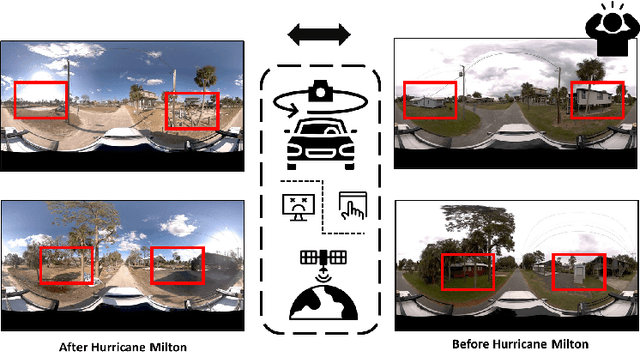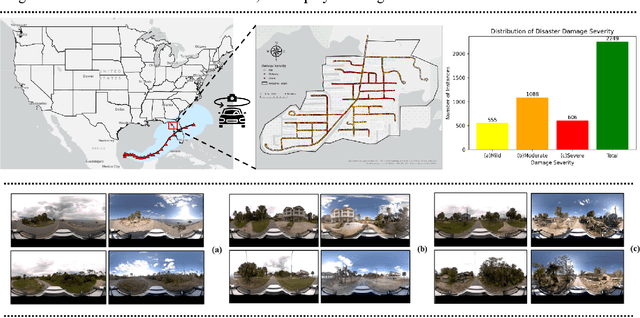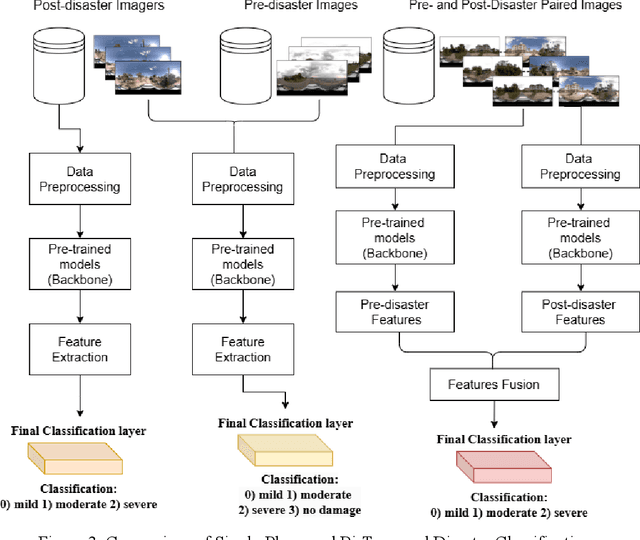Lei Zou
GILT: An LLM-Free, Tuning-Free Graph Foundational Model for In-Context Learning
Oct 06, 2025Abstract:Graph Neural Networks (GNNs) are powerful tools for precessing relational data but often struggle to generalize to unseen graphs, giving rise to the development of Graph Foundational Models (GFMs). However, current GFMs are challenged by the extreme heterogeneity of graph data, where each graph can possess a unique feature space, label set, and topology. To address this, two main paradigms have emerged. The first leverages Large Language Models (LLMs), but is fundamentally text-dependent, thus struggles to handle the numerical features in vast graphs. The second pre-trains a structure-based model, but the adaptation to new tasks typically requires a costly, per-graph tuning stage, creating a critical efficiency bottleneck. In this work, we move beyond these limitations and introduce \textbf{G}raph \textbf{I}n-context \textbf{L}earning \textbf{T}ransformer (GILT), a framework built on an LLM-free and tuning-free architecture. GILT introduces a novel token-based framework for in-context learning (ICL) on graphs, reframing classification tasks spanning node, edge and graph levels in a unified framework. This mechanism is the key to handling heterogeneity, as it is designed to operate on generic numerical features. Further, its ability to understand class semantics dynamically from the context enables tuning-free adaptation. Comprehensive experiments show that GILT achieves stronger few-shot performance with significantly less time than LLM-based or tuning-based baselines, validating the effectiveness of our approach.
GAP: Graph-Assisted Prompts for Dialogue-based Medication Recommendation
May 19, 2025Abstract:Medication recommendations have become an important task in the healthcare domain, especially in measuring the accuracy and safety of medical dialogue systems (MDS). Different from the recommendation task based on electronic health records (EHRs), dialogue-based medication recommendations require research on the interaction details between patients and doctors, which is crucial but may not exist in EHRs. Recent advancements in large language models (LLM) have extended the medical dialogue domain. These LLMs can interpret patients' intent and provide medical suggestions including medication recommendations, but some challenges are still worth attention. During a multi-turn dialogue, LLMs may ignore the fine-grained medical information or connections across the dialogue turns, which is vital for providing accurate suggestions. Besides, LLMs may generate non-factual responses when there is a lack of domain-specific knowledge, which is more risky in the medical domain. To address these challenges, we propose a \textbf{G}raph-\textbf{A}ssisted \textbf{P}rompts (\textbf{GAP}) framework for dialogue-based medication recommendation. It extracts medical concepts and corresponding states from dialogue to construct an explicitly patient-centric graph, which can describe the neglected but important information. Further, combined with external medical knowledge graphs, GAP can generate abundant queries and prompts, thus retrieving information from multiple sources to reduce the non-factual responses. We evaluate GAP on a dialogue-based medication recommendation dataset and further explore its potential in a more difficult scenario, dynamically diagnostic interviewing. Extensive experiments demonstrate its competitive performance when compared with strong baselines.
A Comprehensive Survey of Reward Models: Taxonomy, Applications, Challenges, and Future
Apr 12, 2025Abstract:Reward Model (RM) has demonstrated impressive potential for enhancing Large Language Models (LLM), as RM can serve as a proxy for human preferences, providing signals to guide LLMs' behavior in various tasks. In this paper, we provide a comprehensive overview of relevant research, exploring RMs from the perspectives of preference collection, reward modeling, and usage. Next, we introduce the applications of RMs and discuss the benchmarks for evaluation. Furthermore, we conduct an in-depth analysis of the challenges existing in the field and dive into the potential research directions. This paper is dedicated to providing beginners with a comprehensive introduction to RMs and facilitating future studies. The resources are publicly available at github\footnote{https://github.com/JLZhong23/awesome-reward-models}.
Hyperlocal disaster damage assessment using bi-temporal street-view imagery and pre-trained vision models
Apr 12, 2025



Abstract:Street-view images offer unique advantages for disaster damage estimation as they capture impacts from a visual perspective and provide detailed, on-the-ground insights. Despite several investigations attempting to analyze street-view images for damage estimation, they mainly focus on post-disaster images. The potential of time-series street-view images remains underexplored. Pre-disaster images provide valuable benchmarks for accurate damage estimations at building and street levels. These images could aid annotators in objectively labeling post-disaster impacts, improving the reliability of labeled data sets for model training, and potentially enhancing the model performance in damage evaluation. The goal of this study is to estimate hyperlocal, on-the-ground disaster damages using bi-temporal street-view images and advanced pre-trained vision models. Street-view images before and after 2024 Hurricane Milton in Horseshoe Beach, Florida, were collected for experiments. The objectives are: (1) to assess the performance gains of incorporating pre-disaster street-view images as a no-damage category in fine-tuning pre-trained models, including Swin Transformer and ConvNeXt, for damage level classification; (2) to design and evaluate a dual-channel algorithm that reads pair-wise pre- and post-disaster street-view images for hyperlocal damage assessment. The results indicate that incorporating pre-disaster street-view images and employing a dual-channel processing framework can significantly enhance damage assessment accuracy. The accuracy improves from 66.14% with the Swin Transformer baseline to 77.11% with the dual-channel Feature-Fusion ConvNeXt model. This research enables rapid, operational damage assessments at hyperlocal spatial resolutions, providing valuable insights to support effective decision-making in disaster management and resilience planning.
Exploiting Prefix-Tree in Structured Output Interfaces for Enhancing Jailbreak Attacking
Feb 19, 2025Abstract:The rise of Large Language Models (LLMs) has led to significant applications but also introduced serious security threats, particularly from jailbreak attacks that manipulate output generation. These attacks utilize prompt engineering and logit manipulation to steer models toward harmful content, prompting LLM providers to implement filtering and safety alignment strategies. We investigate LLMs' safety mechanisms and their recent applications, revealing a new threat model targeting structured output interfaces, which enable attackers to manipulate the inner logit during LLM generation, requiring only API access permissions. To demonstrate this threat model, we introduce a black-box attack framework called AttackPrefixTree (APT). APT exploits structured output interfaces to dynamically construct attack patterns. By leveraging prefixes of models' safety refusal response and latent harmful outputs, APT effectively bypasses safety measures. Experiments on benchmark datasets indicate that this approach achieves higher attack success rate than existing methods. This work highlights the urgent need for LLM providers to enhance security protocols to address vulnerabilities arising from the interaction between safety patterns and structured outputs.
DySpec: Faster Speculative Decoding with Dynamic Token Tree Structure
Oct 15, 2024Abstract:While speculative decoding has recently appeared as a promising direction for accelerating the inference of large language models (LLMs), the speedup and scalability are strongly bounded by the token acceptance rate. Prevalent methods usually organize predicted tokens as independent chains or fixed token trees, which fails to generalize to diverse query distributions. In this paper, we propose DySpec, a faster speculative decoding algorithm with a novel dynamic token tree structure. We begin by bridging the draft distribution and acceptance rate from intuitive and empirical clues, and successfully show that the two variables are strongly correlated. Based on this, we employ a greedy strategy to dynamically expand the token tree at run time. Theoretically, we show that our method can achieve optimal results under mild assumptions. Empirically, DySpec yields a higher acceptance rate and speedup than fixed trees. DySpec can drastically improve the throughput and reduce the latency of token generation across various data distribution and model sizes, which significantly outperforms strong competitors, including Specinfer and Sequoia. Under low temperature setting, DySpec can improve the throughput up to 9.1$\times$ and reduce the latency up to 9.4$\times$ on Llama2-70B. Under high temperature setting, DySpec can also improve the throughput up to 6.21$\times$, despite the increasing difficulty of speculating more than one token per step for draft model.
MedDiT: A Knowledge-Controlled Diffusion Transformer Framework for Dynamic Medical Image Generation in Virtual Simulated Patient
Aug 22, 2024Abstract:Medical education relies heavily on Simulated Patients (SPs) to provide a safe environment for students to practice clinical skills, including medical image analysis. However, the high cost of recruiting qualified SPs and the lack of diverse medical imaging datasets have presented significant challenges. To address these issues, this paper introduces MedDiT, a novel knowledge-controlled conversational framework that can dynamically generate plausible medical images aligned with simulated patient symptoms, enabling diverse diagnostic skill training. Specifically, MedDiT integrates various patient Knowledge Graphs (KGs), which describe the attributes and symptoms of patients, to dynamically prompt Large Language Models' (LLMs) behavior and control the patient characteristics, mitigating hallucination during medical conversation. Additionally, a well-tuned Diffusion Transformer (DiT) model is incorporated to generate medical images according to the specified patient attributes in the KG. In this paper, we present the capabilities of MedDiT through a practical demonstration, showcasing its ability to act in diverse simulated patient cases and generate the corresponding medical images. This can provide an abundant and interactive learning experience for students, advancing medical education by offering an immersive simulation platform for future healthcare professionals. The work sheds light on the feasibility of incorporating advanced technologies like LLM, KG, and DiT in education applications, highlighting their potential to address the challenges faced in simulated patient-based medical education.
MMPKUBase: A Comprehensive and High-quality Chinese Multi-modal Knowledge Graph
Aug 03, 2024Abstract:Multi-modal knowledge graphs have emerged as a powerful approach for information representation, combining data from different modalities such as text, images, and videos. While several such graphs have been constructed and have played important roles in applications like visual question answering and recommendation systems, challenges persist in their development. These include the scarcity of high-quality Chinese knowledge graphs and limited domain coverage in existing multi-modal knowledge graphs. This paper introduces MMPKUBase, a robust and extensive Chinese multi-modal knowledge graph that covers diverse domains, including birds, mammals, ferns, and more, comprising over 50,000 entities and over 1 million filtered images. To ensure data quality, we employ Prototypical Contrastive Learning and the Isolation Forest algorithm to refine the image data. Additionally, we have developed a user-friendly platform to facilitate image attribute exploration.
Combining Optimal Transport and Embedding-Based Approaches for More Expressiveness in Unsupervised Graph Alignment
Jun 19, 2024



Abstract:Unsupervised graph alignment finds the one-to-one node correspondence between a pair of attributed graphs by only exploiting graph structure and node features. One category of existing works first computes the node representation and then matches nodes with close embeddings, which is intuitive but lacks a clear objective tailored for graph alignment in the unsupervised setting. The other category reduces the problem to optimal transport (OT) via Gromov-Wasserstein (GW) learning with a well-defined objective but leaves a large room for exploring the design of transport cost. We propose a principled approach to combine their advantages motivated by theoretical analysis of model expressiveness. By noticing the limitation of discriminative power in separating matched and unmatched node pairs, we improve the cost design of GW learning with feature transformation, which enables feature interaction across dimensions. Besides, we propose a simple yet effective embedding-based heuristic inspired by the Weisfeiler-Lehman test and add its prior knowledge to OT for more expressiveness when handling non-Euclidean data. Moreover, we are the first to guarantee the one-to-one matching constraint by reducing the problem to maximum weight matching. The algorithm design effectively combines our OT and embedding-based predictions via stacking, an ensemble learning strategy. We propose a model framework named \texttt{CombAlign} integrating all the above modules to refine node alignment progressively. Through extensive experiments, we demonstrate significant improvements in alignment accuracy compared to state-of-the-art approaches and validate the effectiveness of the proposed modules.
Leveraging Large Language Model as Simulated Patients for Clinical Education
Apr 25, 2024



Abstract:Simulated Patients (SPs) play a crucial role in clinical medical education by providing realistic scenarios for student practice. However, the high cost of training and hiring qualified SPs, along with the heavy workload and potential risks they face in consistently portraying actual patients, limit students' access to this type of clinical training. Consequently, the integration of computer program-based simulated patients has emerged as a valuable educational tool in recent years. With the rapid development of Large Language Models (LLMs), their exceptional capabilities in conversational artificial intelligence and role-playing have been demonstrated, making them a feasible option for implementing Virtual Simulated Patient (VSP). In this paper, we present an integrated model-agnostic framework called CureFun that harnesses the potential of LLMs in clinical medical education. This framework facilitates natural conversations between students and simulated patients, evaluates their dialogue, and provides suggestions to enhance students' clinical inquiry skills. Through comprehensive evaluations, our approach demonstrates more authentic and professional SP-scenario dialogue flows compared to other LLM-based chatbots, thus proving its proficiency in simulating patients. Additionally, leveraging CureFun's evaluation ability, we assess several medical LLMs and discuss the possibilities and limitations of using LLMs as virtual doctors from the perspective of their diagnostic abilities.
 Add to Chrome
Add to Chrome Add to Firefox
Add to Firefox Add to Edge
Add to Edge